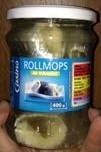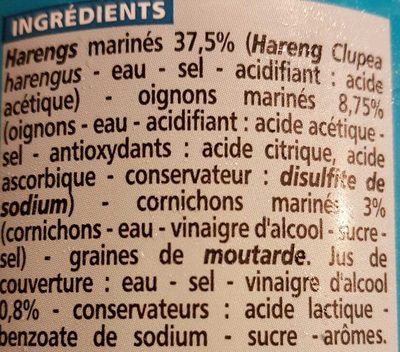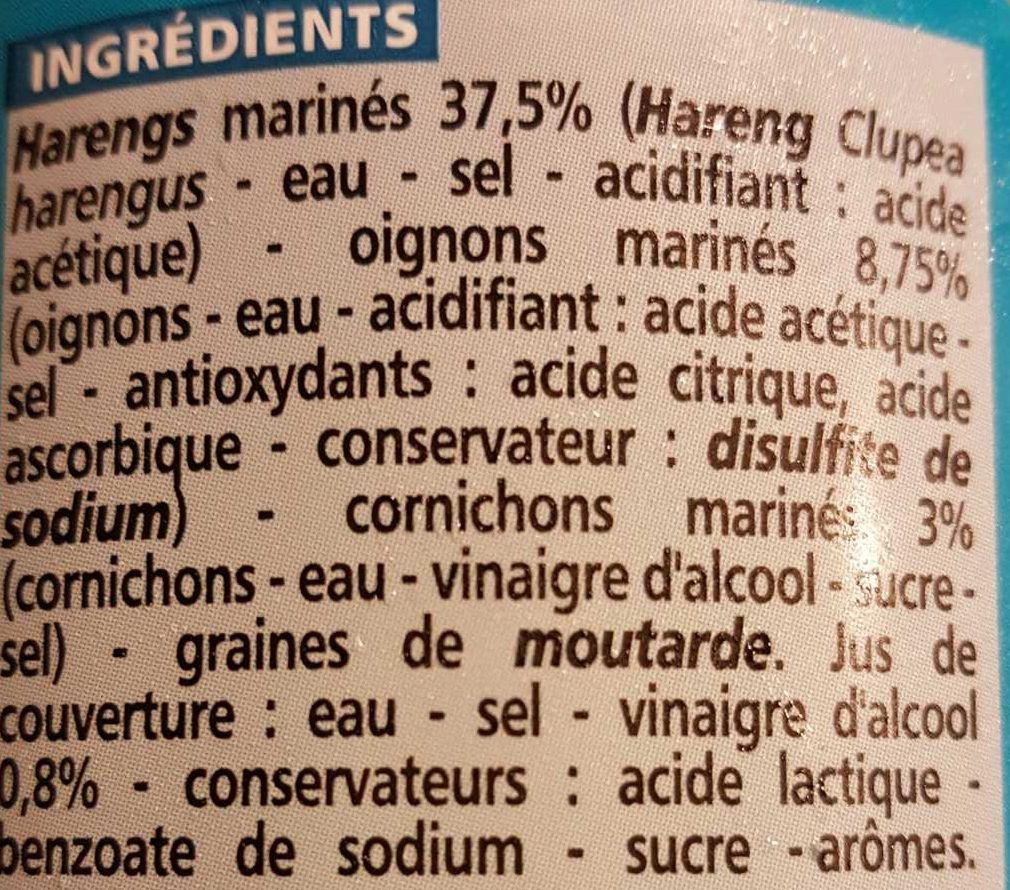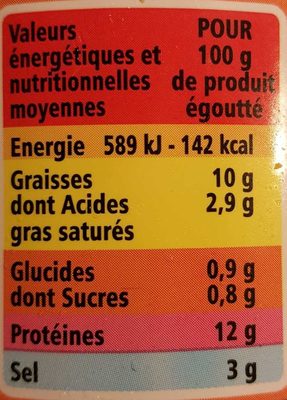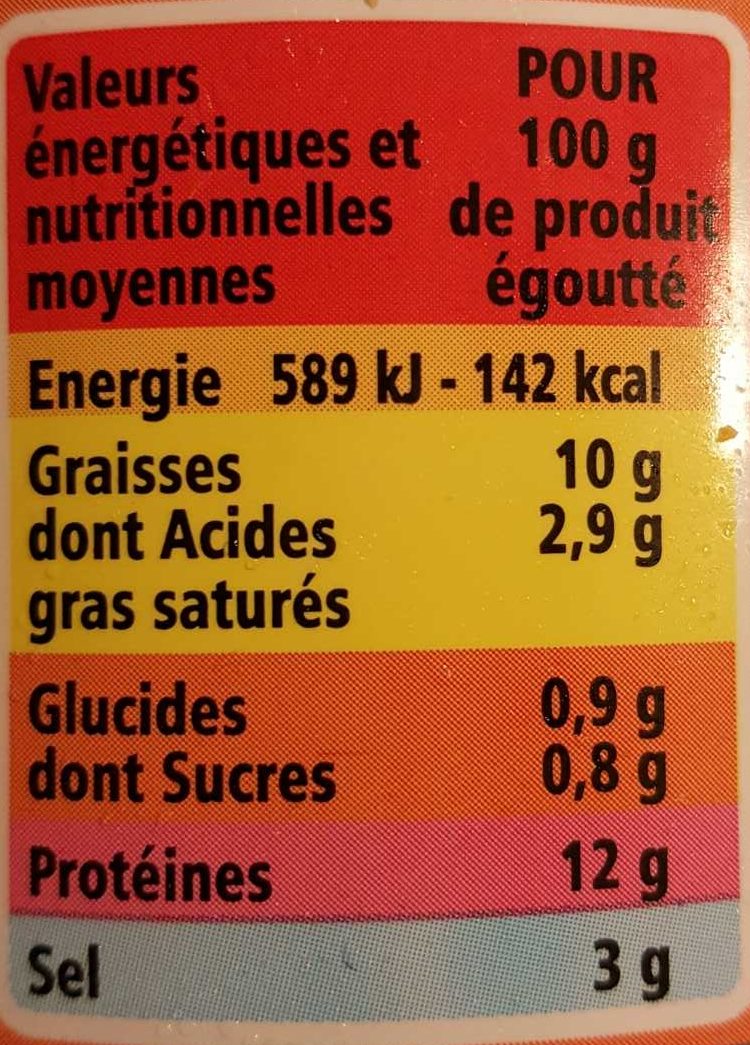Help us make food transparency the norm!
As a non-profit organization, we depend on your donations to continue informing consumers around the world about what they eat.
The food revolution starts with you!
Rollmops au vinaigre - Casino - 400 g
Rollmops au vinaigre - Casino - 400 g
This product page is not complete. You can help to complete it by editing it and adding more data from the photos we have, or by taking more photos using the app for Android or iPhone/iPad. Thank you!
×
Some of the data for this product has been provided directly by the manufacturer casino.
Barcode: 3222473888825 (EAN / EAN-13)
Common name: Harengs marinés au vinaigre roulés sur oignons, cornichons et carottes marinés
Quantity: 400 g
Brands: Casino
Categories: Seafood, Fishes and their products, Fishes, Fatty fishes, Herring, Pickled herring, Rollmops
Origin of ingredients: Atlantic Ocean, North-East Atlantic Ocean
Traceability code: EMB 62160V - Boulogne-sur-Mer (Pas-de-Calais, France), PL 22.021.804 WE
Stores: GEANT CASINO, Casino
Countries where sold: France
Matching with your preferences
Health
Ingredients
-
40 ingredients
French: Eau - harengs marinés 37,5% [harengs (clupea harengus) - eau - sel - acidifiant : acide acétique] - oignons marinés 8,7% [oignons - eau - acidifiant : acide acétique - sel - antioxydants : acide citrique, acide ascorbique - conservateur : disulfite de sodium (contient sulfites)] - cornichons marinés 3% (cornichons - eau - vinaigre d'alcool - sucre - sel) - carottes marinées 2,5% (carottes - eau - vinaigre d'alcool - sucre - sel) - sel - vinaigre d'alcool 0,8% - graines de moutarde - acidifiant : acide lactique - sucre - conservateur : benzoate de sodium - arômes.traces d'œufs, soja,lait, céleri et céréales contenant du gluten.Allergens: Fish, Mustard, Sulphur dioxide and sulphites, fr:disulfiteTraces: Celery, Eggs, Gluten, Milk, Soybeans
Food processing
-
Ultra processed foods
Elements that indicate the product is in the 4 - Ultra processed food and drink products group:
- Ingredient: Flavouring
Food products are classified into 4 groups according to their degree of processing:
- Unprocessed or minimally processed foods
- Processed culinary ingredients
- Processed foods
- Ultra processed foods
The determination of the group is based on the category of the product and on the ingredients it contains.
Additives
-
E211 - Sodium benzoate
Sodium benzoate: Sodium benzoate is a substance which has the chemical formula NaC7H5O2. It is a widely used food preservative, with an E number of E211. It is the sodium salt of benzoic acid and exists in this form when dissolved in water. It can be produced by reacting sodium hydroxide with benzoic acid.Source: Wikipedia
-
E223 - Sodium metabisulphite
Sodium metabisulfite: Sodium metabisulfite or sodium pyrosulfite -IUPAC spelling; Br. E. sodium metabisulphite or sodium pyrosulphite- is an inorganic compound of chemical formula Na2S2O5. The substance is sometimes referred to as disodium metabisulfite. It is used as a disinfectant, antioxidant, and preservative agent.Source: Wikipedia
-
E260 - Acetic acid
Acetic acid: Acetic acid , systematically named ethanoic acid , is a colorless liquid organic compound with the chemical formula CH3COOH -also written as CH3CO2H or C2H4O2-. When undiluted, it is sometimes called glacial acetic acid. Vinegar is no less than 4% acetic acid by volume, making acetic acid the main component of vinegar apart from water. Acetic acid has a distinctive sour taste and pungent smell. In addition to household vinegar, it is mainly produced as a precursor to polyvinyl acetate and cellulose acetate. It is classified as a weak acid since it only partially dissociates in solution, but concentrated acetic acid is corrosive and can attack the skin. Acetic acid is the second simplest carboxylic acid -after formic acid-. It consists of a methyl group attached to a carboxyl group. It is an important chemical reagent and industrial chemical, used primarily in the production of cellulose acetate for photographic film, polyvinyl acetate for wood glue, and synthetic fibres and fabrics. In households, diluted acetic acid is often used in descaling agents. In the food industry, acetic acid is controlled by the food additive code E260 as an acidity regulator and as a condiment. In biochemistry, the acetyl group, derived from acetic acid, is fundamental to all forms of life. When bound to coenzyme A, it is central to the metabolism of carbohydrates and fats. The global demand for acetic acid is about 6.5 million metric tons per year -Mt/a-, of which approximately 1.5 Mt/a is met by recycling; the remainder is manufactured from methanol. Vinegar is mostly dilute acetic acid, often produced by fermentation and subsequent oxidation of ethanol.Source: Wikipedia
-
E270 - Lactic acid
Lactic acid: Lactic acid is an organic compound with the formula CH3CH-OH-COOH. In its solid state, it is white and water-soluble. In its liquid state, it is colorless. It is produced both naturally and synthetically. With a hydroxyl group adjacent to the carboxyl group, lactic acid is classified as an alpha-hydroxy acid -AHA-. In the form of its conjugate base called lactate, it plays a role in several biochemical processes. In solution, it can ionize a proton from the carboxyl group, producing the lactate ion CH3CH-OH-CO−2. Compared to acetic acid, its pKa is 1 unit less, meaning lactic acid deprotonates ten times more easily than acetic acid does. This higher acidity is the consequence of the intramolecular hydrogen bonding between the α-hydroxyl and the carboxylate group. Lactic acid is chiral, consisting of two optical isomers. One is known as L--+--lactic acid or -S--lactic acid and the other, its mirror image, is D--−--lactic acid or -R--lactic acid. A mixture of the two in equal amounts is called DL-lactic acid, or racemic lactic acid. Lactic acid is hygroscopic. DL-lactic acid is miscible with water and with ethanol above its melting point which is around 17 or 18 °C. D-lactic acid and L-lactic acid have a higher melting point. In animals, L-lactate is constantly produced from pyruvate via the enzyme lactate dehydrogenase -LDH- in a process of fermentation during normal metabolism and exercise. It does not increase in concentration until the rate of lactate production exceeds the rate of lactate removal, which is governed by a number of factors, including monocarboxylate transporters, concentration and isoform of LDH, and oxidative capacity of tissues. The concentration of blood lactate is usually 1–2 mM at rest, but can rise to over 20 mM during intense exertion and as high as 25 mM afterward. In addition to other biological roles, L-lactic acid is the primary endogenous agonist of hydroxycarboxylic acid receptor 1 -HCA1-, which is a Gi/o-coupled G protein-coupled receptor -GPCR-.In industry, lactic acid fermentation is performed by lactic acid bacteria, which convert simple carbohydrates such as glucose, sucrose, or galactose to lactic acid. These bacteria can also grow in the mouth; the acid they produce is responsible for the tooth decay known as caries. In medicine, lactate is one of the main components of lactated Ringer's solution and Hartmann's solution. These intravenous fluids consist of sodium and potassium cations along with lactate and chloride anions in solution with distilled water, generally in concentrations isotonic with human blood. It is most commonly used for fluid resuscitation after blood loss due to trauma, surgery, or burns.Source: Wikipedia
-
E330 - Citric acid
Citric acid is a natural organic acid found in citrus fruits such as lemons, oranges, and limes.
It is widely used in the food industry as a flavor enhancer, acidulant, and preservative due to its tart and refreshing taste.
Citric acid is safe for consumption when used in moderation and is considered a generally recognized as safe (GRAS) food additive by regulatory agencies worldwide.
Ingredients analysis
-
Palm oil free
No ingredients containing palm oil detected
-
Non-vegan
Non-vegan ingredients: Herring, Herring, Atlantic herring
-
Non-vegetarian
Non-vegetarian ingredients: Herring, Herring, Atlantic herring
-
Details of the analysis of the ingredients
fr: Eau, _harengs_ 37.5% (_harengs_ (clupea harengus), eau, sel, acidifiant (acide acétique)), oignons 8.7% (oignons, eau, acidifiant (acide acétique), sel, antioxydants (acide citrique), acide ascorbique, conservateur (disulfite de sodium)), cornichons 3% (cornichons, eau, vinaigre d'alcool, sucre, sel), carottes 2.5% (carottes, eau, vinaigre d'alcool, sucre, sel), sel, vinaigre d'alcool 0.8%, graines de _moutarde_, acidifiant (acide lactique), sucre, conservateur (benzoate de sodium), arômes- Eau -> en:water - vegan: yes - vegetarian: yes - ciqual_food_code: 18066 - percent_min: 41 - percent_max: 46.7
- _harengs_ -> en:herring - vegan: no - vegetarian: no - ciqual_food_code: 26011 - percent_min: 37.5 - percent: 37.5 - percent_max: 37.5
- _harengs_ -> en:herring - vegan: no - vegetarian: no - ciqual_food_code: 26011 - percent_min: 12.75 - percent_max: 37.5
- clupea harengus -> en:atlantic-herring - vegan: no - vegetarian: no - ciqual_food_code: 26011 - percent_min: 12.75 - percent_max: 37.5
- eau -> en:water - vegan: yes - vegetarian: yes - ciqual_food_code: 18066 - percent_min: 0 - percent_max: 18.75
- sel -> en:salt - vegan: yes - vegetarian: yes - ciqual_food_code: 11058 - percent_min: 0 - percent_max: 3
- acidifiant -> en:acid - percent_min: 0 - percent_max: 3
- acide acétique -> en:e260 - vegan: yes - vegetarian: yes - percent_min: 0 - percent_max: 3
- _harengs_ -> en:herring - vegan: no - vegetarian: no - ciqual_food_code: 26011 - percent_min: 12.75 - percent_max: 37.5
- oignons -> en:onion - vegan: yes - vegetarian: yes - ciqual_food_code: 20034 - percent_min: 8.7 - percent: 8.7 - percent_max: 8.7
- oignons -> en:onion - vegan: yes - vegetarian: yes - ciqual_food_code: 20034 - percent_min: 1.24285714285714 - percent_max: 8.7
- eau -> en:water - vegan: yes - vegetarian: yes - ciqual_food_code: 18066 - percent_min: 0 - percent_max: 4.35
- acidifiant -> en:acid - percent_min: 0 - percent_max: 2.9
- acide acétique -> en:e260 - vegan: yes - vegetarian: yes - percent_min: 0 - percent_max: 2.9
- sel -> en:salt - vegan: yes - vegetarian: yes - ciqual_food_code: 11058 - percent_min: 0 - percent_max: 2.175
- antioxydants -> en:antioxidant - percent_min: 0 - percent_max: 1.74
- acide citrique -> en:e330 - vegan: yes - vegetarian: yes - percent_min: 0 - percent_max: 1.74
- acide ascorbique -> en:e300 - vegan: yes - vegetarian: yes - percent_min: 0 - percent_max: 1.45
- conservateur -> en:preservative - percent_min: 0 - percent_max: 1.24285714285714
- disulfite de sodium -> en:e223 - vegan: yes - vegetarian: yes - percent_min: 0 - percent_max: 1.24285714285714
- cornichons -> en:gherkin - vegan: yes - vegetarian: yes - ciqual_proxy_food_code: 11004 - percent_min: 3 - percent: 3 - percent_max: 3
- cornichons -> en:gherkin - vegan: yes - vegetarian: yes - ciqual_proxy_food_code: 11004 - percent_min: 0.6 - percent_max: 3
- eau -> en:water - vegan: yes - vegetarian: yes - ciqual_food_code: 18066 - percent_min: 0 - percent_max: 1.5
- vinaigre d'alcool -> en:alcohol-vinegar - vegan: yes - vegetarian: yes - ciqual_food_code: 11018 - percent_min: 0 - percent_max: 1
- sucre -> en:sugar - vegan: yes - vegetarian: yes - ciqual_proxy_food_code: 31016 - percent_min: 0 - percent_max: 0.8
- sel -> en:salt - vegan: yes - vegetarian: yes - ciqual_food_code: 11058 - percent_min: 0 - percent_max: 0.6
- carottes -> en:carrot - vegan: yes - vegetarian: yes - ciqual_food_code: 20009 - percent_min: 2.5 - percent: 2.5 - percent_max: 2.5
- carottes -> en:carrot - vegan: yes - vegetarian: yes - ciqual_food_code: 20009 - percent_min: 0.5 - percent_max: 2.5
- eau -> en:water - vegan: yes - vegetarian: yes - ciqual_food_code: 18066 - percent_min: 0 - percent_max: 1.25
- vinaigre d'alcool -> en:alcohol-vinegar - vegan: yes - vegetarian: yes - ciqual_food_code: 11018 - percent_min: 0 - percent_max: 0.833333333333333
- sucre -> en:sugar - vegan: yes - vegetarian: yes - ciqual_proxy_food_code: 31016 - percent_min: 0 - percent_max: 0.625
- sel -> en:salt - vegan: yes - vegetarian: yes - ciqual_food_code: 11058 - percent_min: 0 - percent_max: 0.5
- sel -> en:salt - vegan: yes - vegetarian: yes - ciqual_food_code: 11058 - percent_min: 0.8 - percent_max: 2.5
- vinaigre d'alcool -> en:alcohol-vinegar - vegan: yes - vegetarian: yes - ciqual_food_code: 11018 - percent_min: 0.8 - percent: 0.8 - percent_max: 0.8
- graines de _moutarde_ -> en:mustard-seed - vegan: yes - vegetarian: yes - ciqual_food_code: 11013 - percent_min: 0 - percent_max: 0.8
- acidifiant -> en:acid - percent_min: 0 - percent_max: 0.8
- acide lactique -> en:e270 - vegan: yes - vegetarian: yes - percent_min: 0 - percent_max: 0.8
- sucre -> en:sugar - vegan: yes - vegetarian: yes - ciqual_proxy_food_code: 31016 - percent_min: 0 - percent_max: 0.8
- conservateur -> en:preservative - percent_min: 0 - percent_max: 0.8
- benzoate de sodium -> en:e211 - vegan: yes - vegetarian: yes - percent_min: 0 - percent_max: 0.8
- arômes -> en:flavouring - vegan: maybe - vegetarian: maybe - percent_min: 0 - percent_max: 0.8
Nutrition
-
Poor nutritional quality
⚠ ️Warning: the amount of fruits, vegetables and nuts is not specified on the label, it was estimated from the list of ingredients: 14This product is not considered a beverage for the calculation of the Nutri-Score.
Positive points: 0
- Proteins: 5 / 5 (value: 12, rounded value: 12)
- Fiber: 0 / 5 (value: 0, rounded value: 0)
- Fruits, vegetables, nuts, and colza/walnut/olive oils: 0 / 5 (value: 14.2, rounded value: 14.2)
Negative points: 13
- Energy: 1 / 10 (value: 589, rounded value: 589)
- Sugars: 0 / 10 (value: 0.8, rounded value: 0.8)
- Saturated fat: 2 / 10 (value: 2.9, rounded value: 2.9)
- Sodium: 10 / 10 (value: 1200, rounded value: 1200)
The points for proteins are not counted because the negative points are greater or equal to 11.
Nutritional score: (13 - 0)
Nutri-Score:
-
Nutrient levels
-
Fat in moderate quantity (10%)
What you need to know- A high consumption of fat, especially saturated fats, can raise cholesterol, which increases the risk of heart diseases.
Recommendation: Limit the consumption of fat and saturated fat- Choose products with lower fat and saturated fat content.
-
Saturated fat in moderate quantity (2.9%)
What you need to know- A high consumption of fat, especially saturated fats, can raise cholesterol, which increases the risk of heart diseases.
Recommendation: Limit the consumption of fat and saturated fat- Choose products with lower fat and saturated fat content.
-
Sugars in low quantity (0.8%)
What you need to know- A high consumption of sugar can cause weight gain and tooth decay. It also augments the risk of type 2 diabetes and cardio-vascular diseases.
Recommendation: Limit the consumption of sugar and sugary drinks- Sugary drinks (such as sodas, fruit beverages, and fruit juices and nectars) should be limited as much as possible (no more than 1 glass a day).
- Choose products with lower sugar content and reduce the consumption of products with added sugars.
-
Salt in high quantity (3%)
What you need to know- A high consumption of salt (or sodium) can cause raised blood pressure, which can increase the risk of heart disease and stroke.
- Many people who have high blood pressure do not know it, as there are often no symptoms.
- Most people consume too much salt (on average 9 to 12 grams per day), around twice the recommended maximum level of intake.
Recommendation: Limit the consumption of salt and salted food- Reduce the quantity of salt used when cooking, and don't salt again at the table.
- Limit the consumption of salty snacks and choose products with lower salt content.
-
-
Nutrition facts
Nutrition facts As sold
for 100 g / 100 mlCompared to: Rollmops Energy 589 kj
(142 kcal)-2% Fat 10 g +6% Saturated fat 2.9 g +25% Carbohydrates 0.9 g -57% Sugars 0.8 g -23% Fiber - Proteins 12 g +3% Salt 3 g +22% Fruits‚ vegetables‚ nuts and rapeseed‚ walnut and olive oils (estimate from ingredients list analysis) 14.2 %
Environment
-
Eco-Score B - Low environmental impact
⚠ ️Select a country in order to include the full impact of transportation.The Eco-Score is an experimental score that summarizes the environmental impacts of food products.→ The Eco-Score was initially developped for France and it is being extended to other European countries. The Eco-Score formula is subject to change as it is regularly improved to make it more precise and better suited to each country.Life cycle analysis
-
Average impact of products of the same category: B (Score: 76/100)
Category: Atlantic herring, marinated, or rollmops
Category: Atlantic herring, marinated, or rollmops
- PEF environmental score: 0.30 (the lower the score, the lower the impact)
- including impact on climate change: 2.31 kg CO2 eq/kg of product
Stage Impact Agriculture
64.7 %Processing
0.0 %Packaging
5.9 %Transportation
25.6 %Distribution
3.0 %Consumption
0.8 %
Bonuses and maluses
-
Missing origins of ingredients information
Malus: -5
⚠ ️ The origins of the ingredients of this product are not indicated.
If they are indicated on the packaging, you can modify the product sheet and add them.
If you are the manufacturer of this product, you can send us the information with our free platform for producers.
-
Packaging with a low impact
Malus: -2
Shape Material Recycling Impact Jar Glass Low ⚠ ️ The information about the packaging of this product is not sufficiently precise (exact shapes and materials of all components of the packaging).⚠ ️ For a more precise calculation of the Eco-Score, you can modify the product page and add them.
If you are the manufacturer of this product, you can send us the information with our free platform for producers.
Eco-Score for this product
-
Impact for this product: B (Score: 69/100)
Product: Rollmops au vinaigre - Casino - 400 g
Life cycle analysis score: 76
Sum of bonuses and maluses: -7
Final score: 69/100
-
Carbon footprint
-
Equal to driving 1.2 km in a petrol car
231 g CO² per 100g of product
The carbon emission figure comes from ADEME's Agribalyse database, for the category: Atlantic herring, marinated, or rollmops (Source: ADEME Agribalyse Database)
Stage Impact Agriculture
46.9 %Processing
0.0 %Packaging
11.9 %Transportation
39.2 %Distribution
1.6 %Consumption
0.3 %
Packaging
-
Packaging with a low impact
-
Packaging parts
Jar (Glass)
-
Packaging materials
Material % Packaging weight Packaging weight per 100 g of product Glass
-
Transportation
-
Origins of ingredients
Missing origins of ingredients information
⚠ ️ The origins of the ingredients of this product are not indicated.
If they are indicated on the packaging, you can modify the product sheet and add them.
If you are the manufacturer of this product, you can send us the information with our free platform for producers.Add the origins of ingredients for this product Add the origins of ingredients for this product
Other information
Other information: péché en atlantique Nord-Est.
Conservation conditions: A conserver entre 0°C et +4°C.
Recycling instructions - To recycle: bocal en verre et couvercle métal
Report a problem
-
Incomplete or incorrect information?
Category, labels, ingredients, allergens, nutritional information, photos etc.
If the information does not match the information on the packaging, please complete or correct it. Open Food Facts is a collaborative database, and every contribution is useful for all.
Data sources
Product added on by openfoodfacts-contributors
Last edit of product page on by sebleouf.
Product page also edited by casino, casino-off, date-limite-app, franck56, packbot, segundo, tacite, teolemon.

